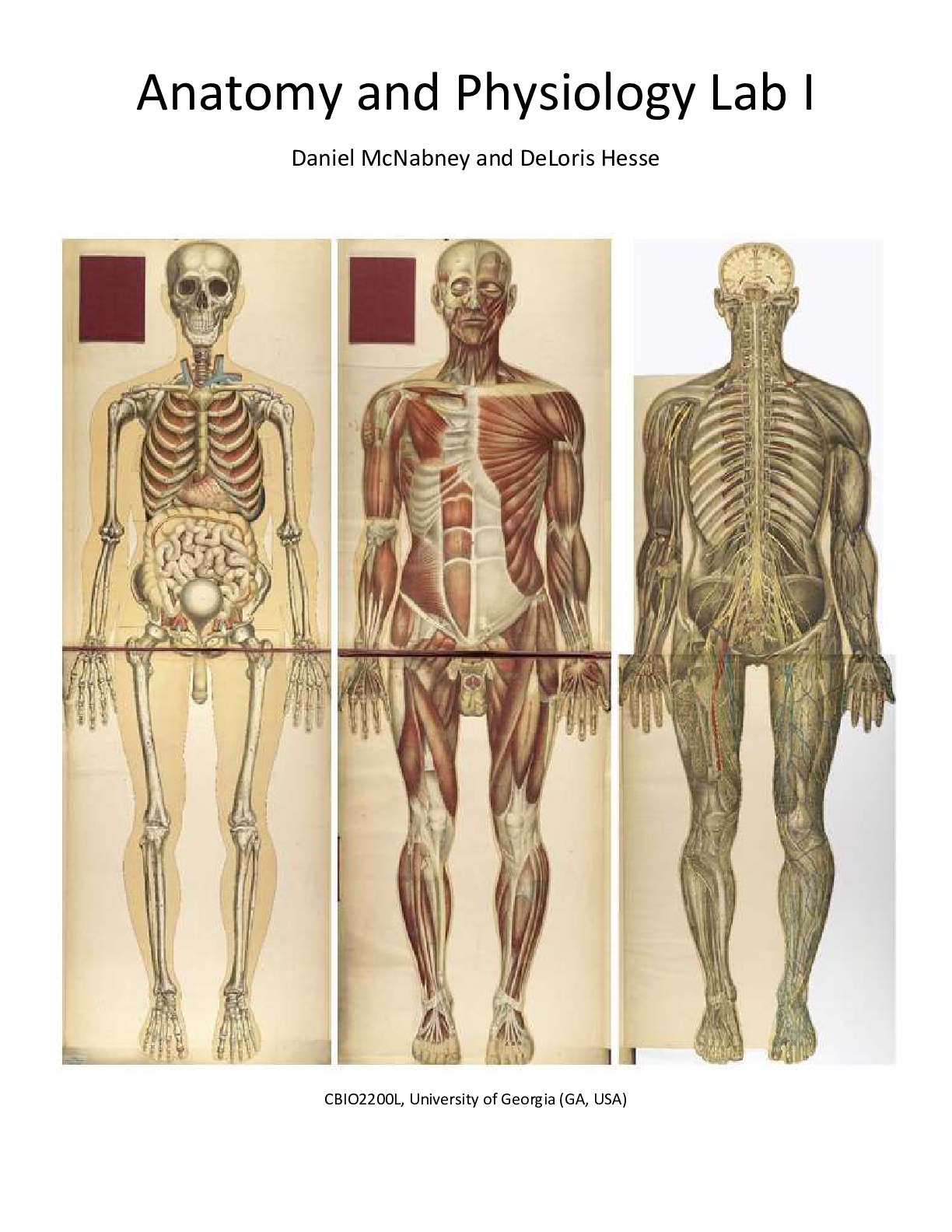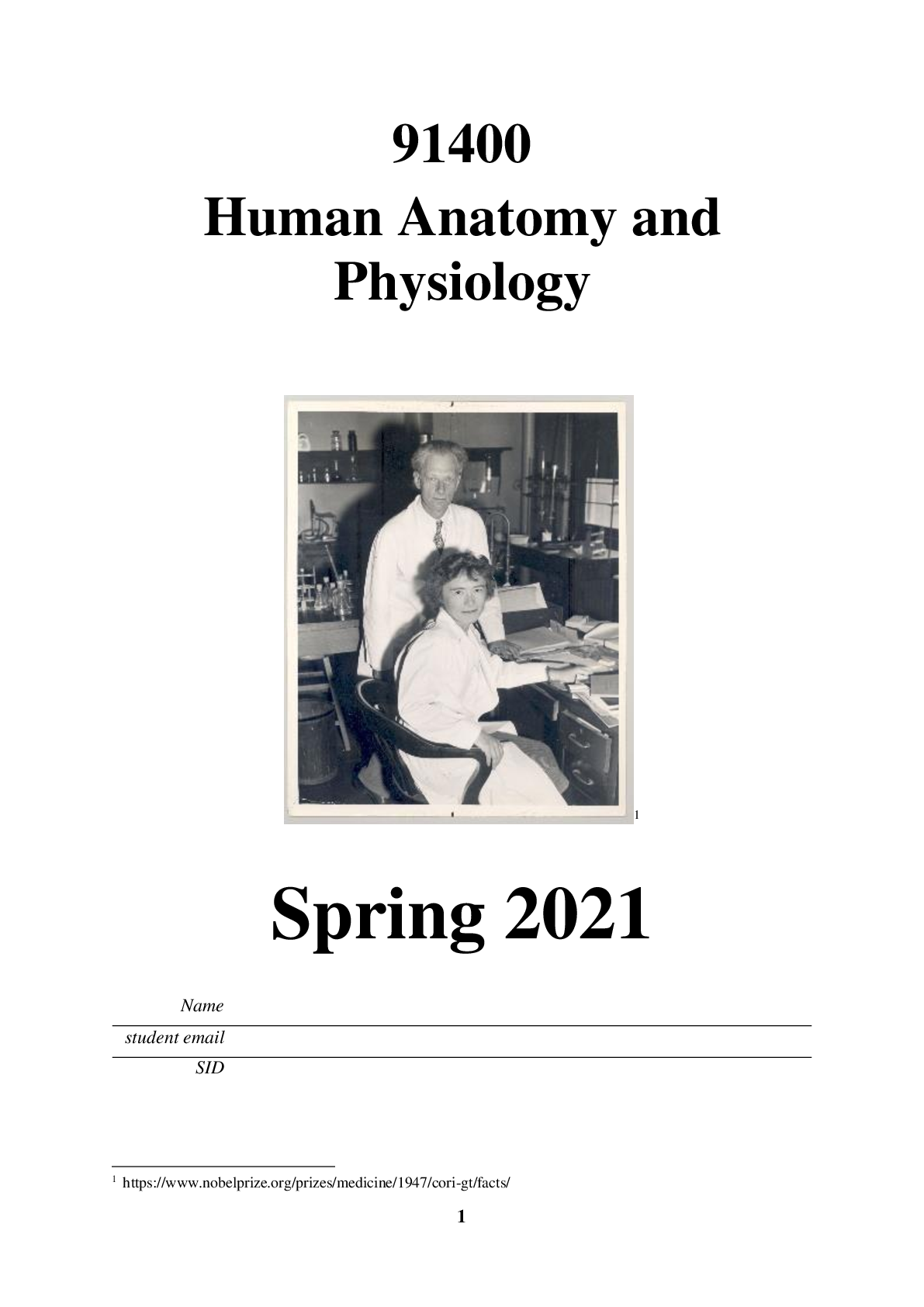*NURSING > Manual > BLGY 231L Anatomy and Physiology II Lab Manual Northwestern State University - NURSING BS 3060AP2 L (All)
BLGY 231L Anatomy and Physiology II Lab Manual Northwestern State University - NURSING BS 3060AP2 Lab Manual Addie Fa17
Document Content and Description Below
BLGY 231L Anatomy and Physiology II Lab Manual Fall 2017 Dr. HinzeTable of Contents Laboratory Safety 1 1 Review of Microscopy 4 2 Review of Metric System 10 3 Homeostasis & Measuring Blood Gl... ucose 12 4 Endocrine Anatomy & Histology 20 5 Endocrine Physiology: Metabolism 24 6 Composition of Blood & Identification of Blood Cells 32 7 Blood Typing 35 8 Complete Blood Count and Associated Diseases 8A RBC Counts & Anemias 41 8B WBC Counts & Infections 47 9 Anatomy of the Heart 52 10 Anatomy of the Vasculature 55 11 Measuring Blood Pressure & ECG 65 12 Analyzing the Heart with EKG 67 13 Anatomy of the Respiratory System 70 14 Spirometry: Measuring Lung Volumes & Capacities 77 15 Respiratory System Mechanics 81 16 Anatomy of the Urinary System 92 17A Acid-Base Balance: Respiratory Compensation 99 17B Acid-Base Balance: Renal Compensation 105 18 Urinary Physiology & Urinalysis 112 19 Anatomy of the Digestive System 117 20 Lipid Profiles 125 21 Anatomy of Reproductive Systems 128 Normal Physiologic Values 1311 Laboratory Safety You must learn & understand safety information in this exercise in order to conduct yourself safely in the laboratory. You will take a quiz over information in this exercise & must score a minimum of 60% to continue in the course. BLGY 231 LAB Safety Guidelines & Contract Many reagents, equipment, & techniques used in the Human Physiology Laboratory are potentially dangerous. If Universal Precautions (Standard Precautions) are followed in the laboratory, the learning experience will be safe & interesting. Rules of laboratory conduct should become a habit & not just memorized information. General Safety Precautions 1. Be prepared to work when you arrive in the laboratory. Prepare before class. 2. Know the location of emergency equipment & how to use them: a. Emergency shower – B311 (chemistry lab) for major chemical spills to the body b. Eye wash station – B326 (prep room) for materials splashed into the eyes (15 minutes of running water per eye) c. First aid kit –B326 (prep room) for minor cuts or ailments 3. Follow fire & other threat warnings that come from the emergency system speaker. 4. Notify your instructor of any personal medical condition which could be of concern in the laboratory setting (such as pregnancy, diabetes, asthma, infectious diseases). Such information will be kept in strict confidence. 5. Prior to beginning lab work, understand any possible hazards inherent to that exercise. 6. Follow all written & oral instructions carefully. 7. Report all accidents to the instructor. You purchased insurance upon enrollment in this lab class. An incident report must be completed as validation that the accident occurred in the laboratory setting before any insurance claim can be filed. 8. Keep work area neat & clean at all times. Store books, purses, coats, etc. on the shelves designated for that purpose. 9. Adhere to safe techniques when using electrical equipment. 10. Put equipment back where it belongs as instructed. 11. MSDS (Material Safety Data Sheets) are supplied by the manufacturer for each chemical. MSDS sheets consist of 14 sections which identify the chemical & give the following types of information: physical data (melting point, boiling point, flash point, etc.), toxicity, hazards, health effects, first aid, reactivity, storage, disposal, protective equipment, & spill-handling procedures. MSDS sheets are available in the prep room (B316) for each chemical used in class. Standard or Universal Precautions: Are used to limit exposure to blood & other potentially infectious materials in this lab. These precautions include 1) Engineering Controls: items used so the worker does not touch infectious materials. a. Use pipette pumps with pipettes. (Do not pipette by mouth.) b. Work over a bench protector that will absorb spills & splashes.2 c. Use a Biohazard Can to dispose of “non-sharp” contaminated materials (bloody gauze, BandAids, or bench protectors, etc.). d. Use a Sharps Container to dispose of “sharp” contaminated materials (used lancets, bloody slides, etc.). 2) Work Practice Controls: methods used so the worker does not contaminate self with infectious materials. a. Appropriate routine hand washing done before the lab begins, at the end of lab, & upon removal of gloves. b. Do not eat or drink in the lab. c. Decontaminate work surfaces with 10% bleach before the lab begins, at the end of lab, & anytime there is an obvious spill or splatter of potentially infectious material. 3) Use of Personal Protective Equipment (PPE) a. Lab coats to be worn during each lab (button it up) unless otherwise instructed. b. Gloves to be worn when handling blood or other body fluids other than your own. c. Closed toe shoes must be worn during each lab [Show More]
Last updated: 2 years ago
Preview 1 out of 152 pages

Buy this document to get the full access instantly
Instant Download Access after purchase
Buy NowInstant download
We Accept:

Reviews( 0 )
$7.00
Can't find what you want? Try our AI powered Search
Document information
Connected school, study & course
About the document
Uploaded On
Apr 05, 2021
Number of pages
152
Written in
Additional information
This document has been written for:
Uploaded
Apr 05, 2021
Downloads
0
Views
133






